
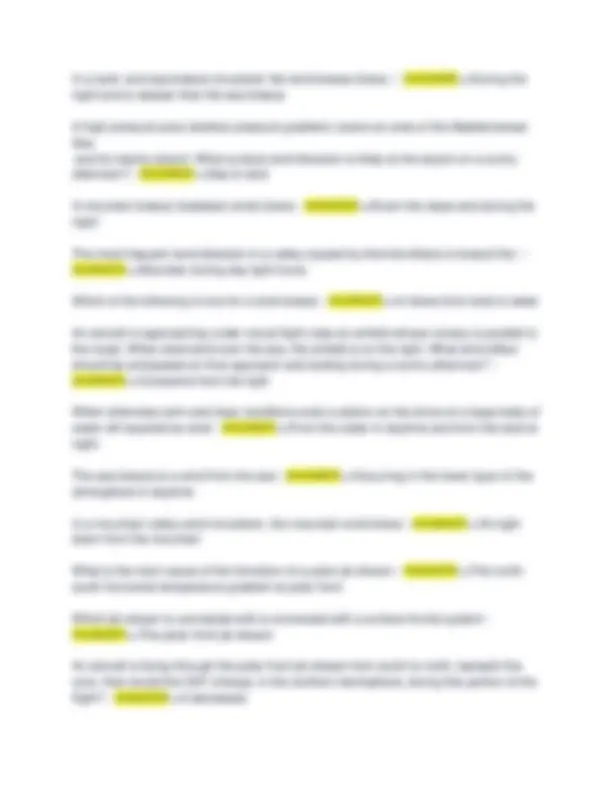
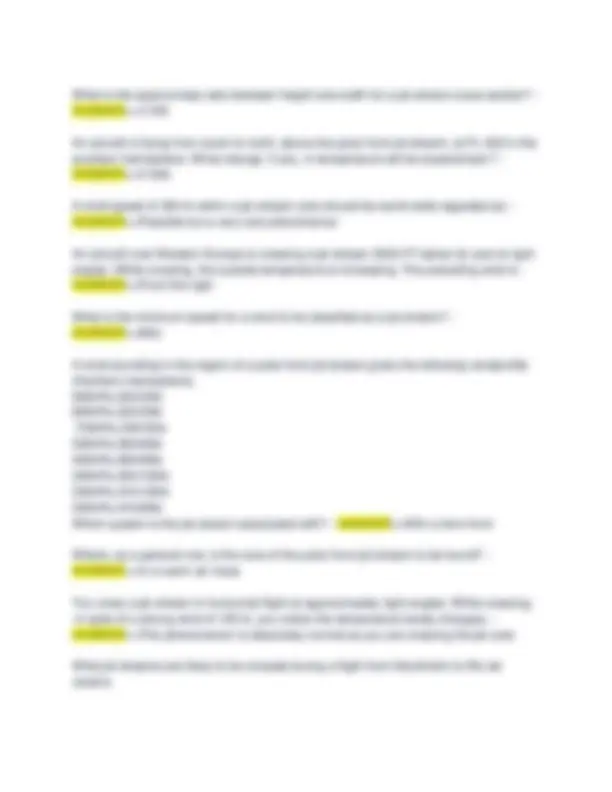
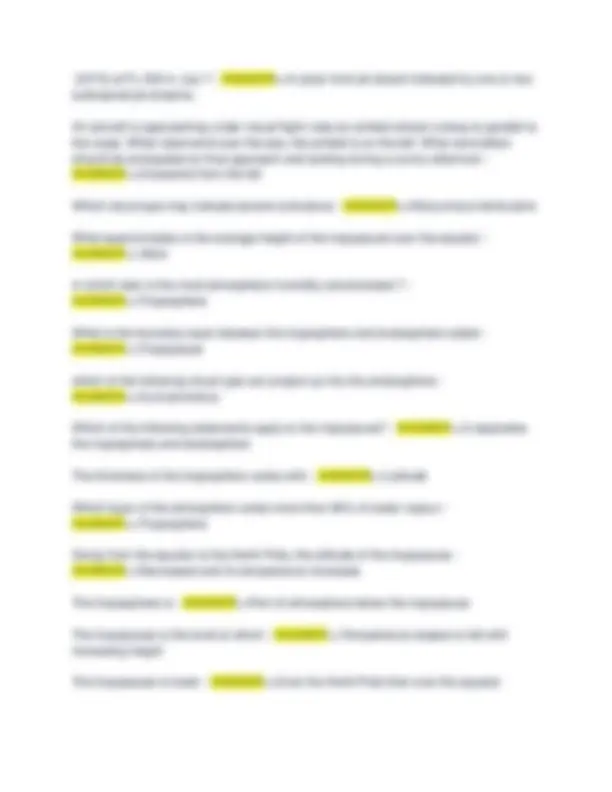
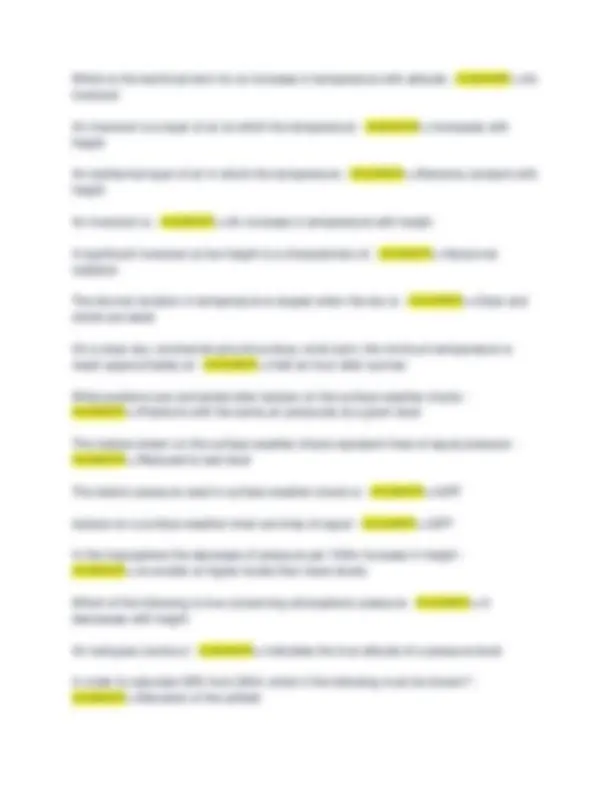
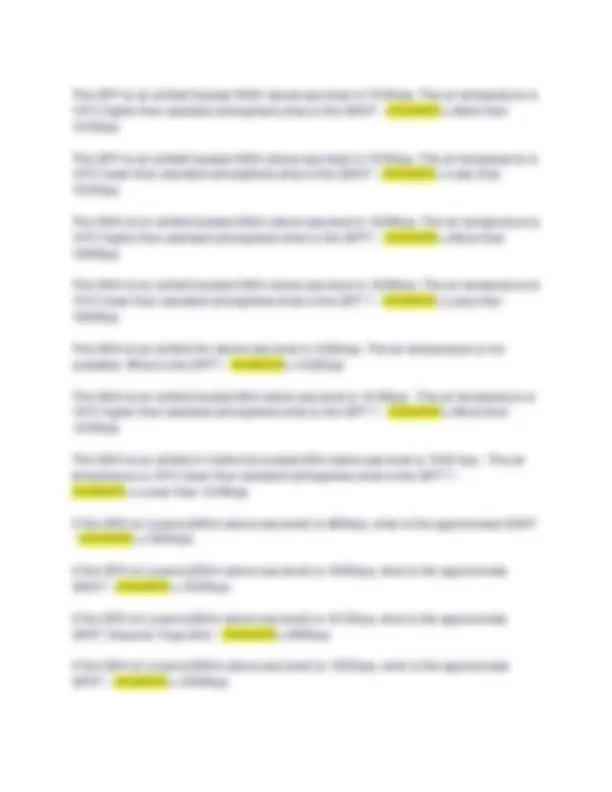
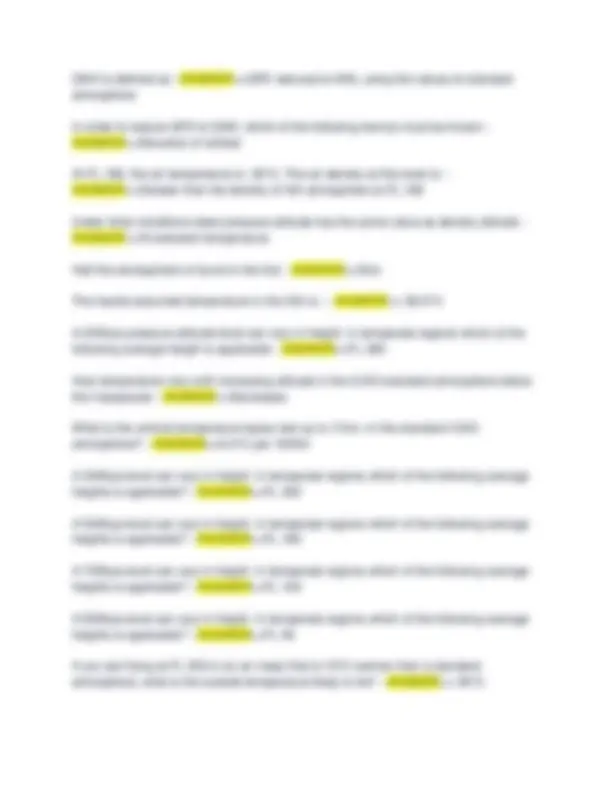

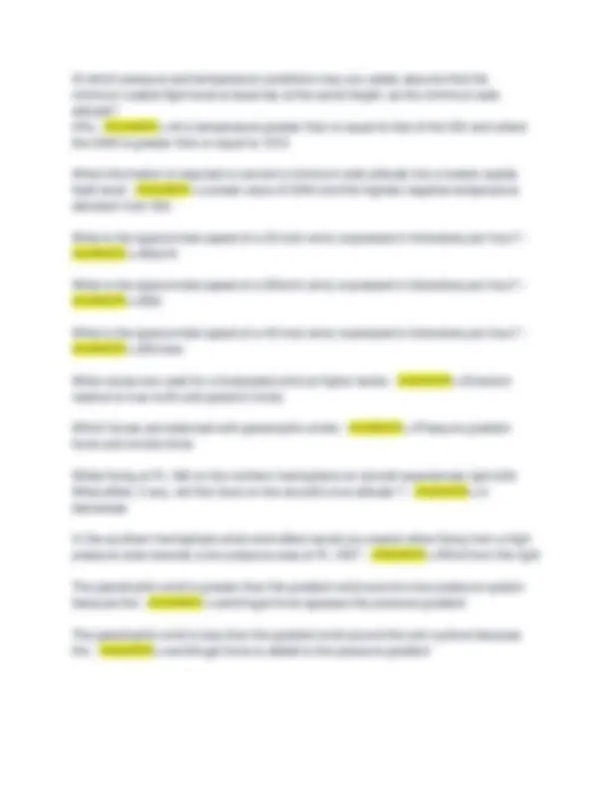
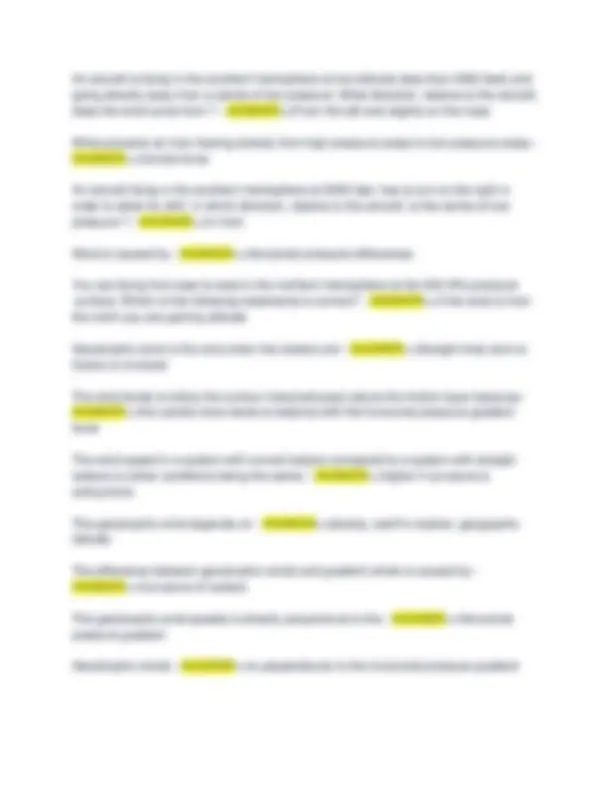

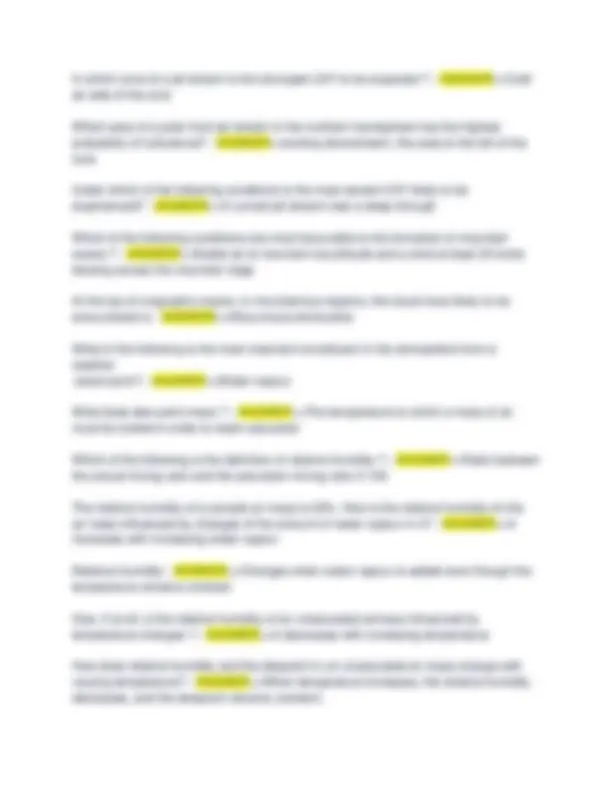
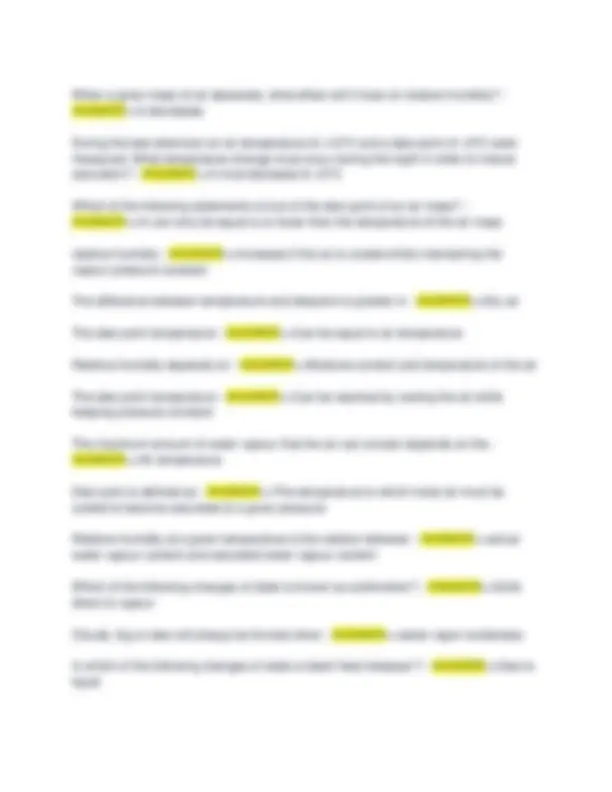
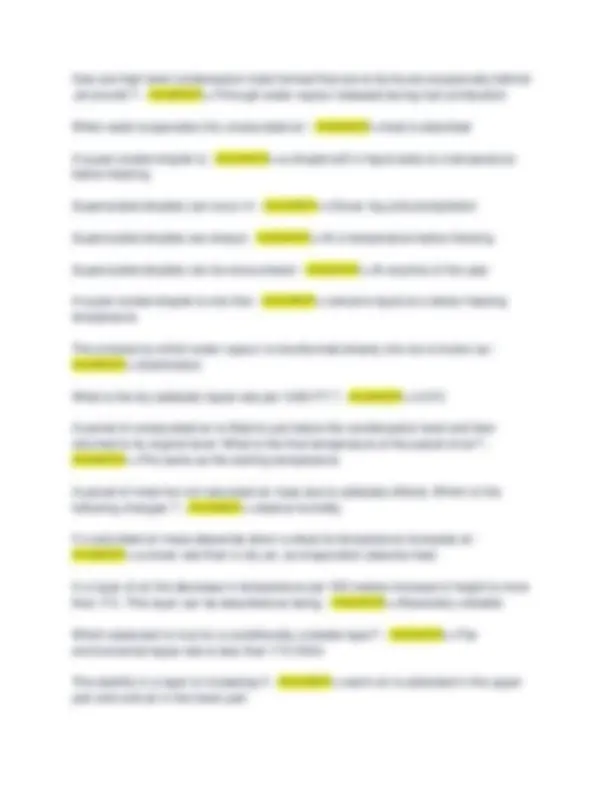
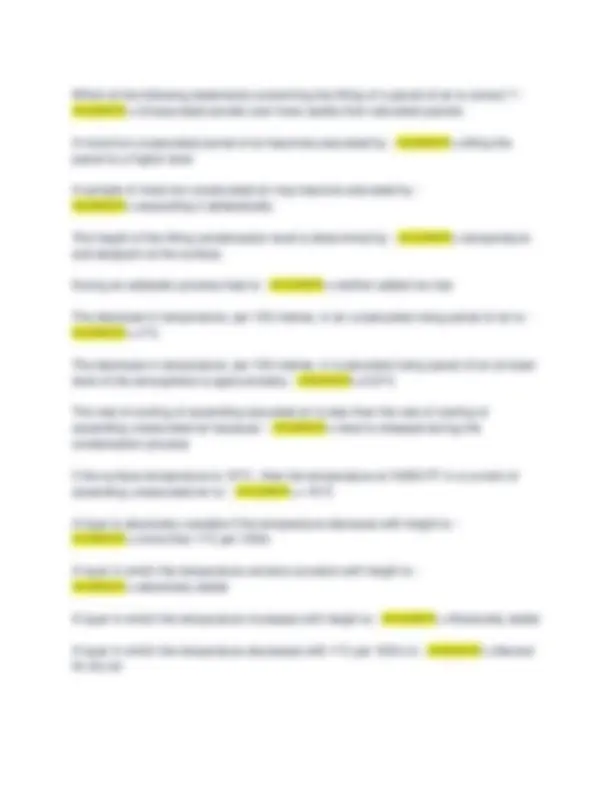
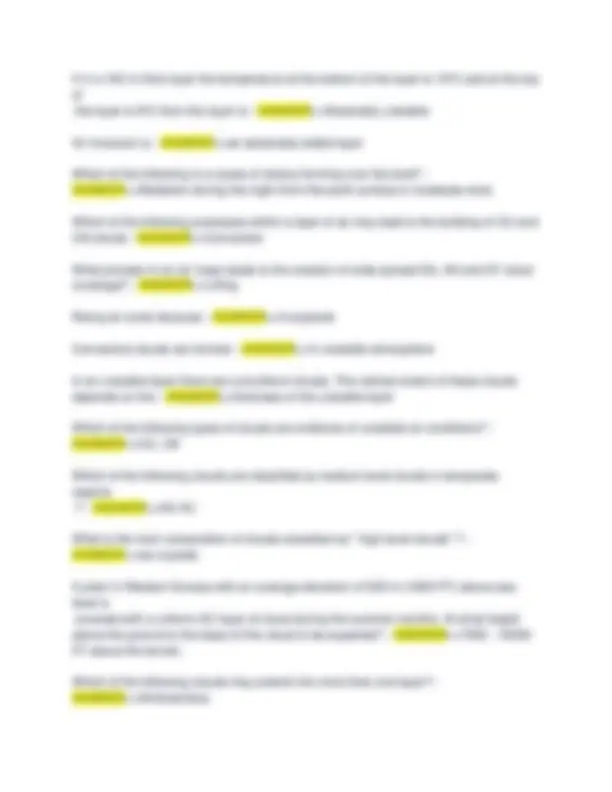
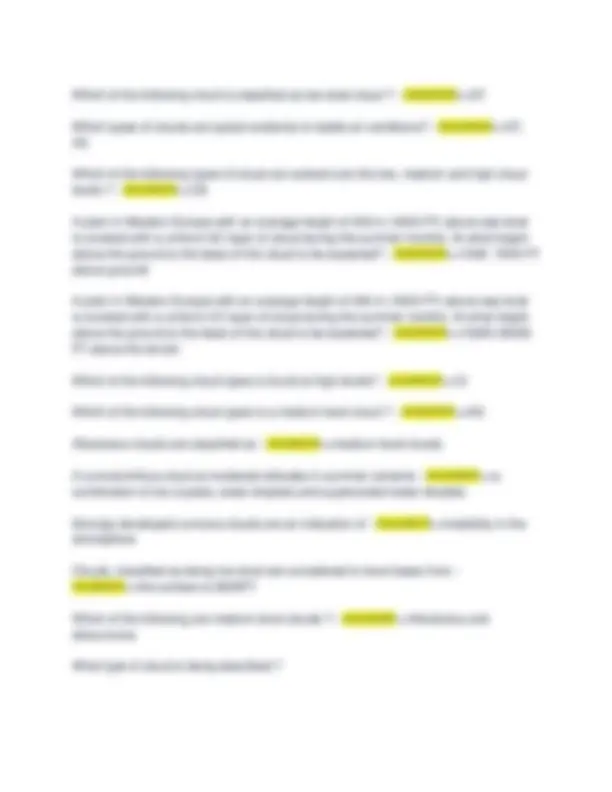
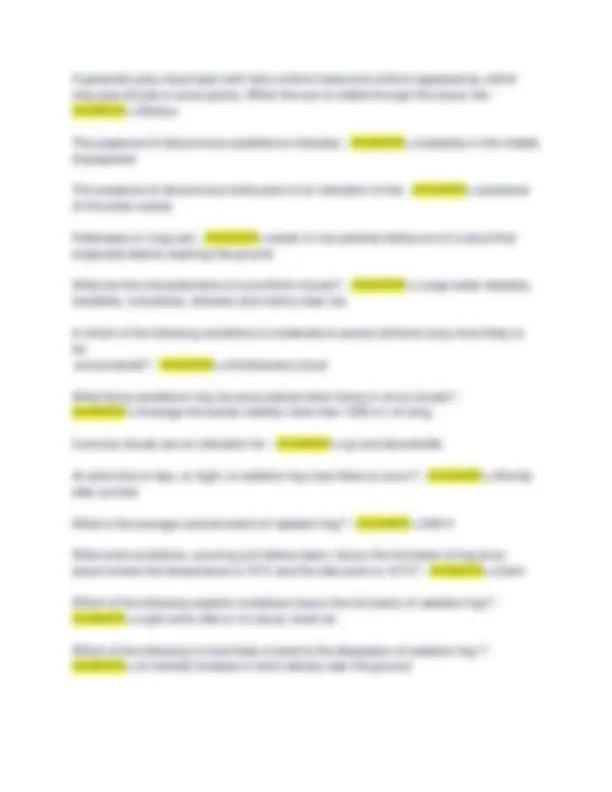

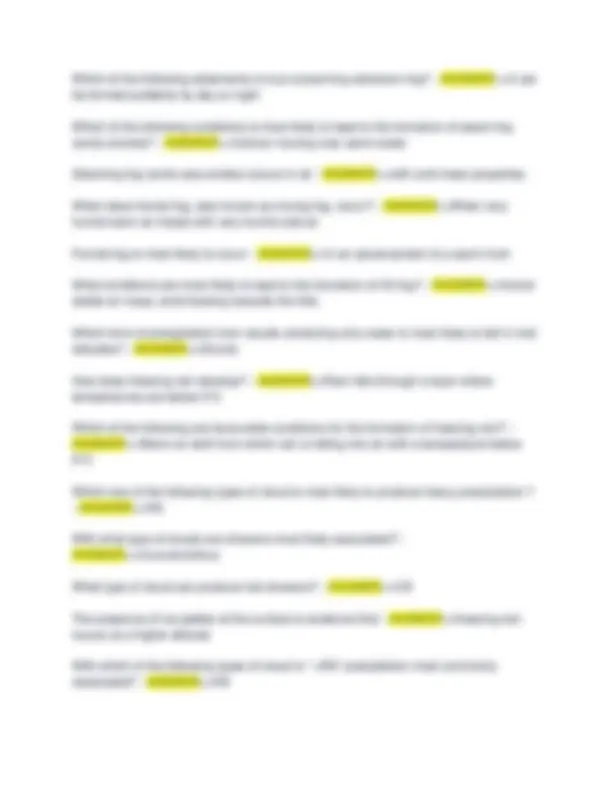
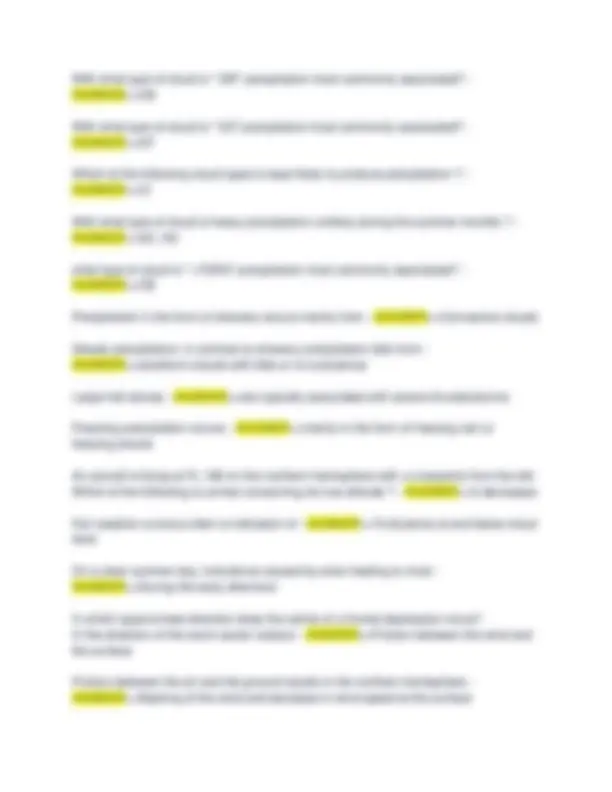
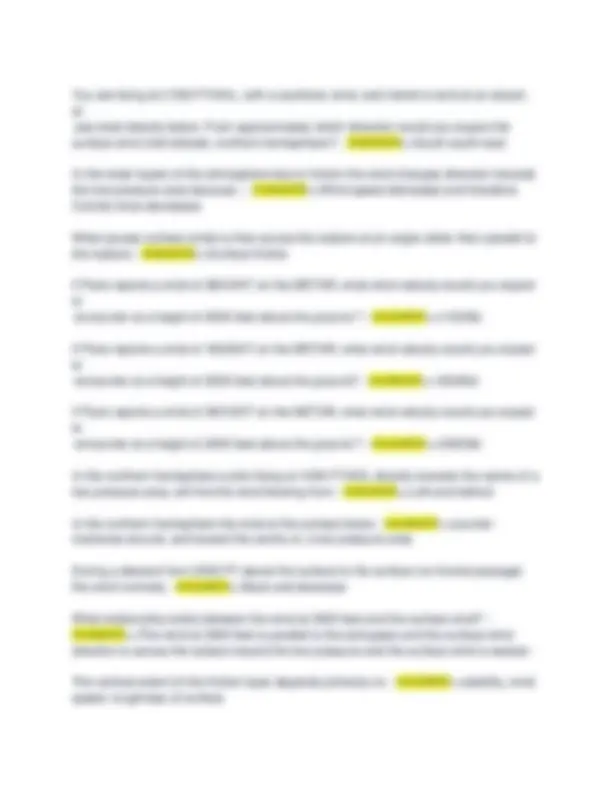
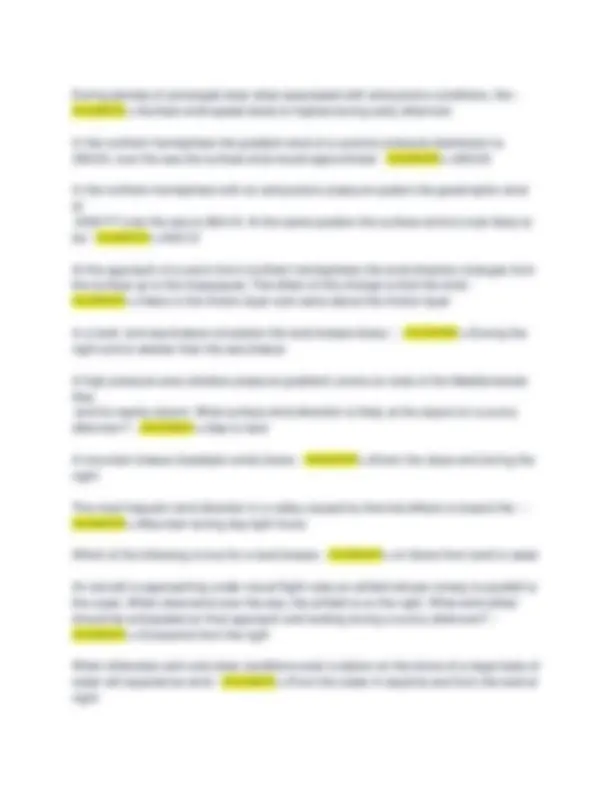
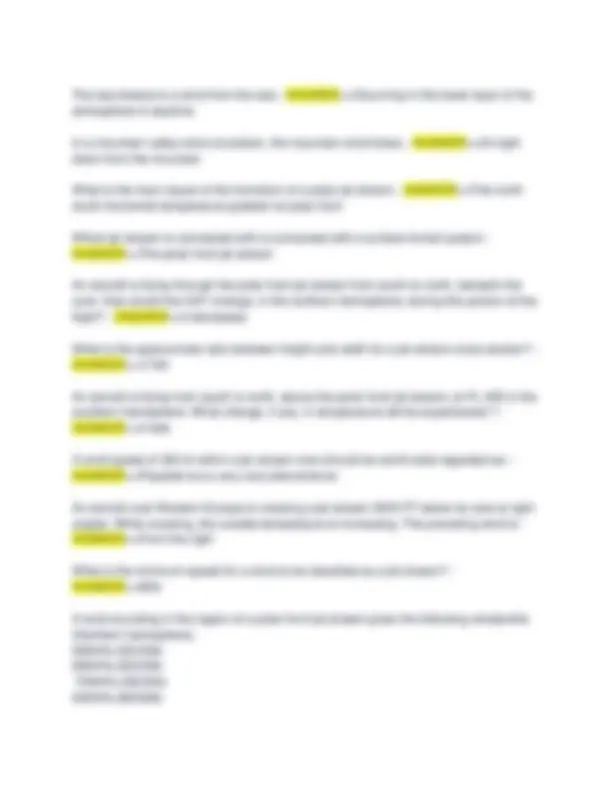

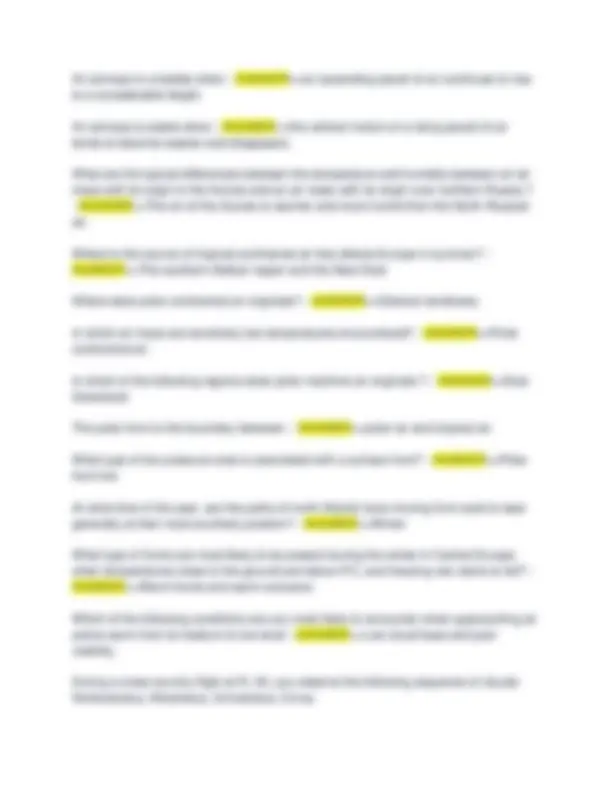
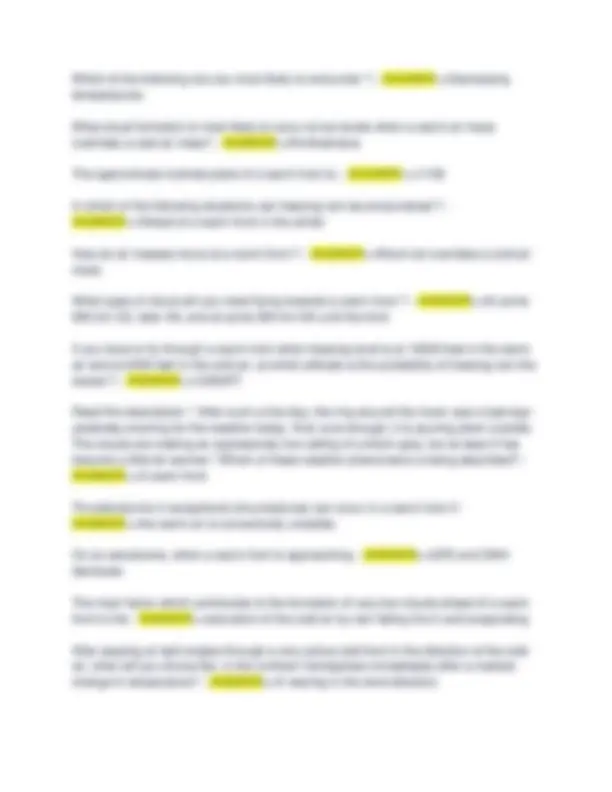
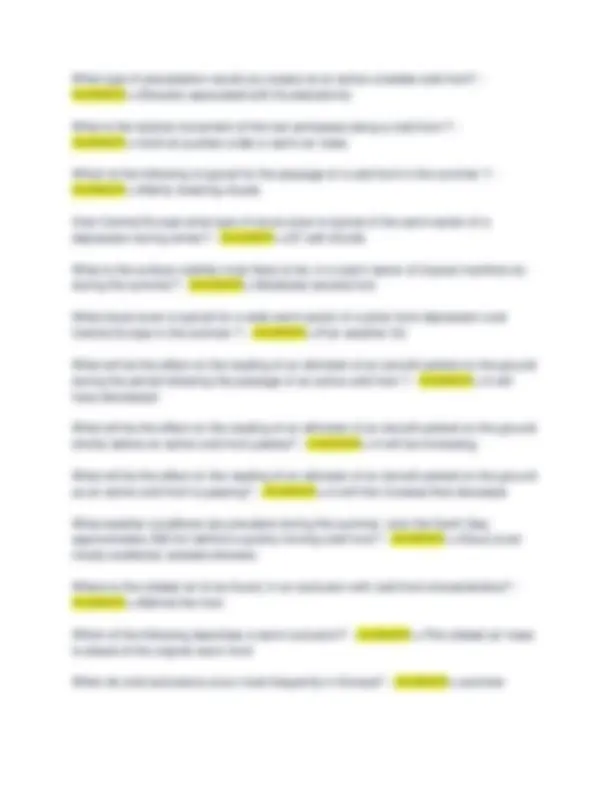
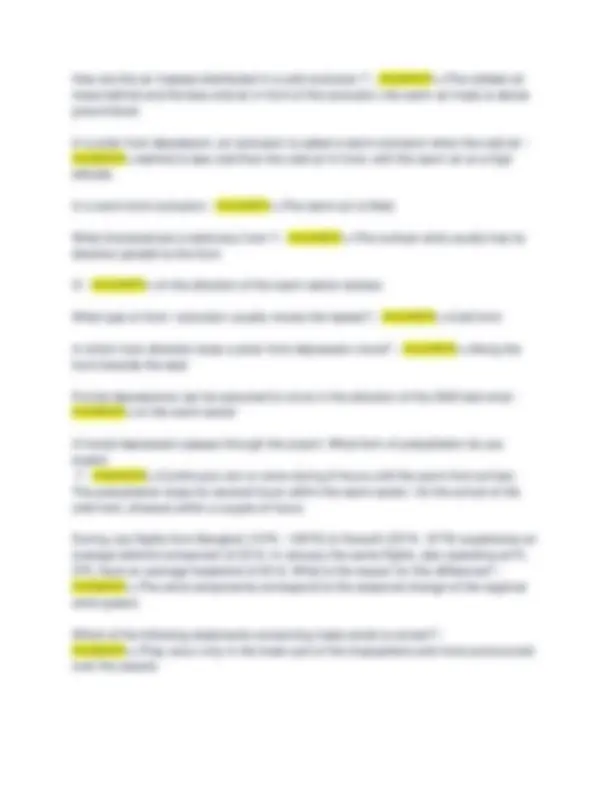
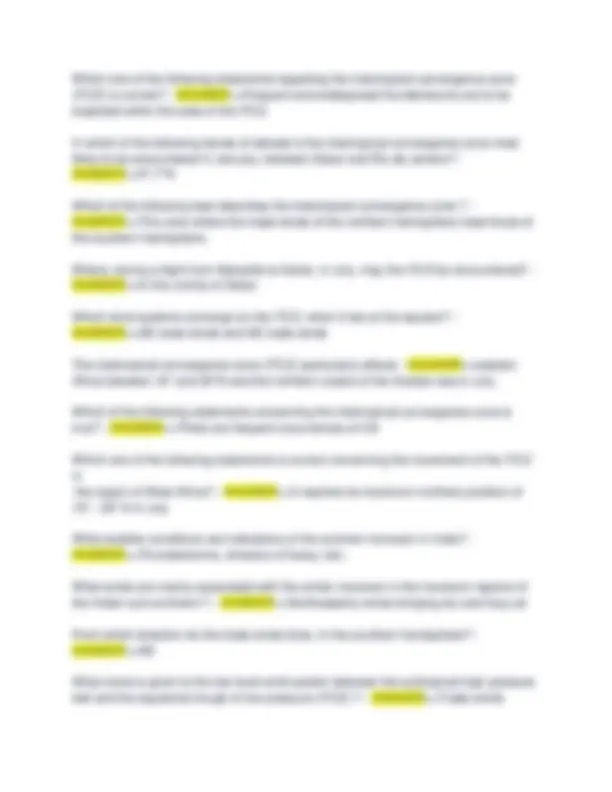


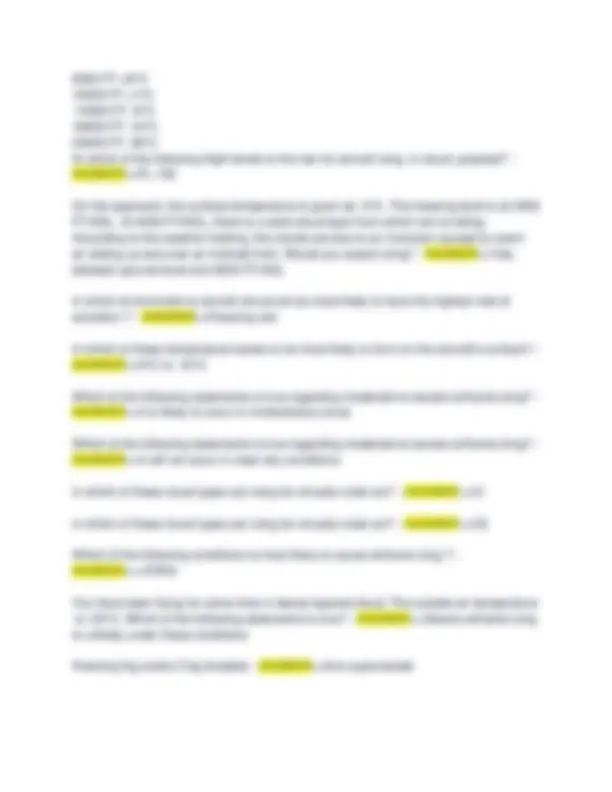


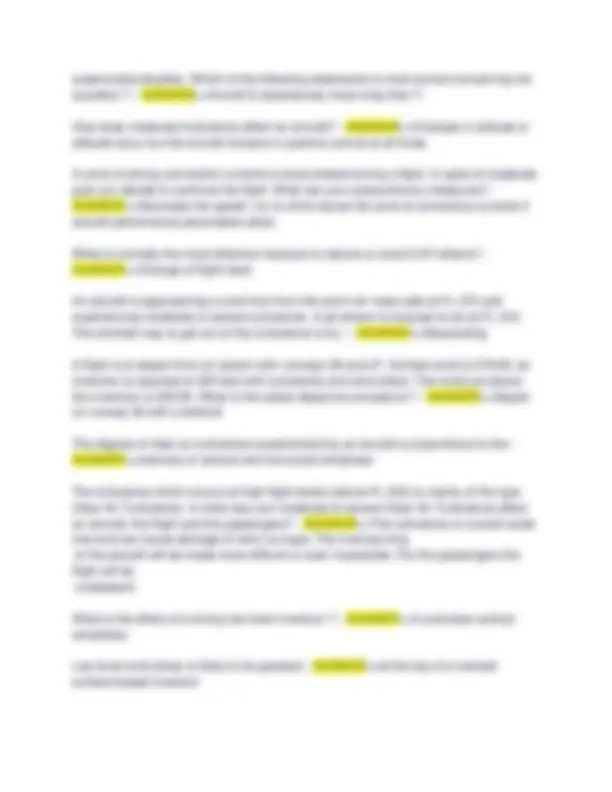

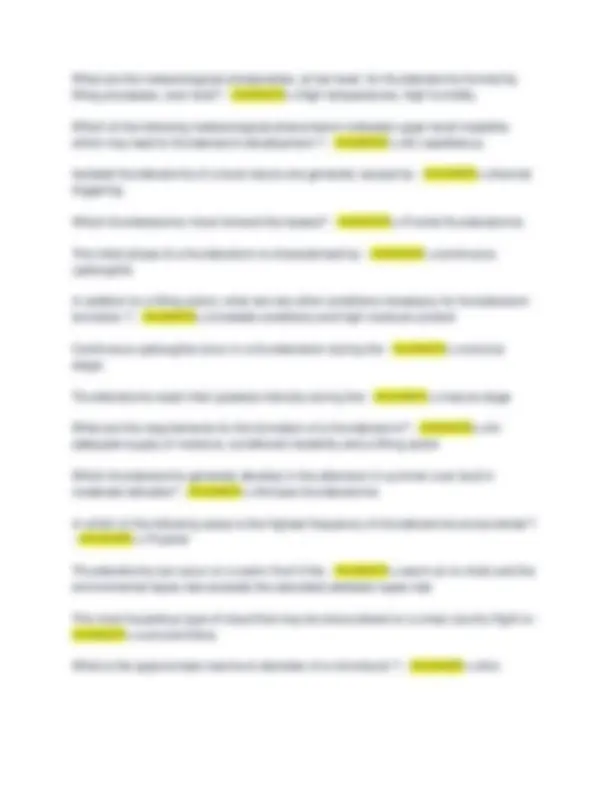



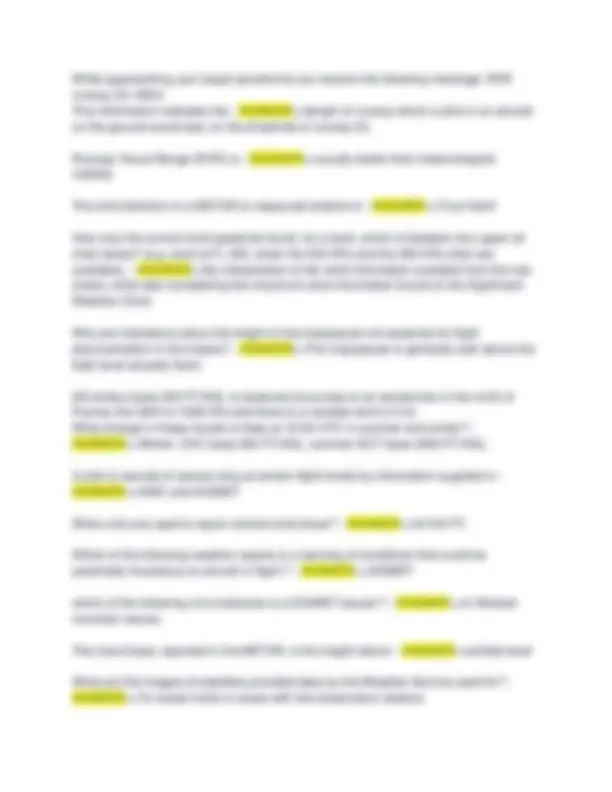


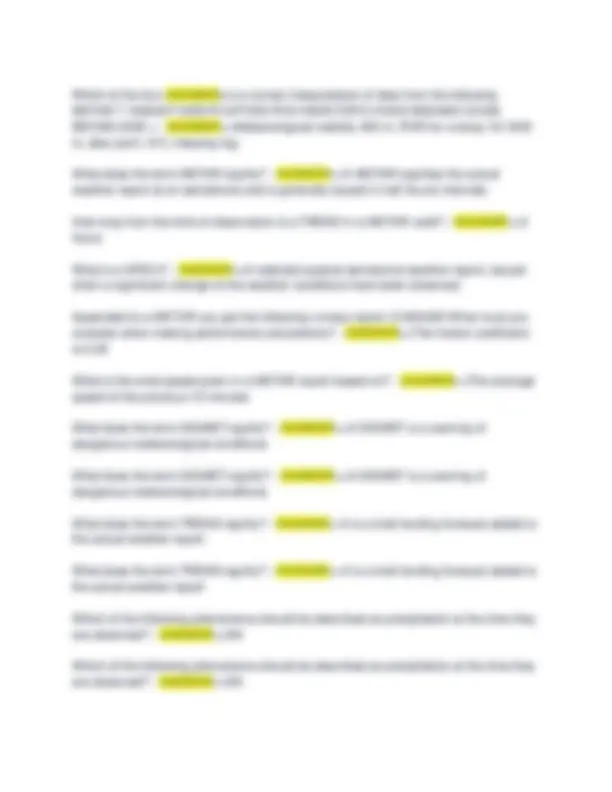
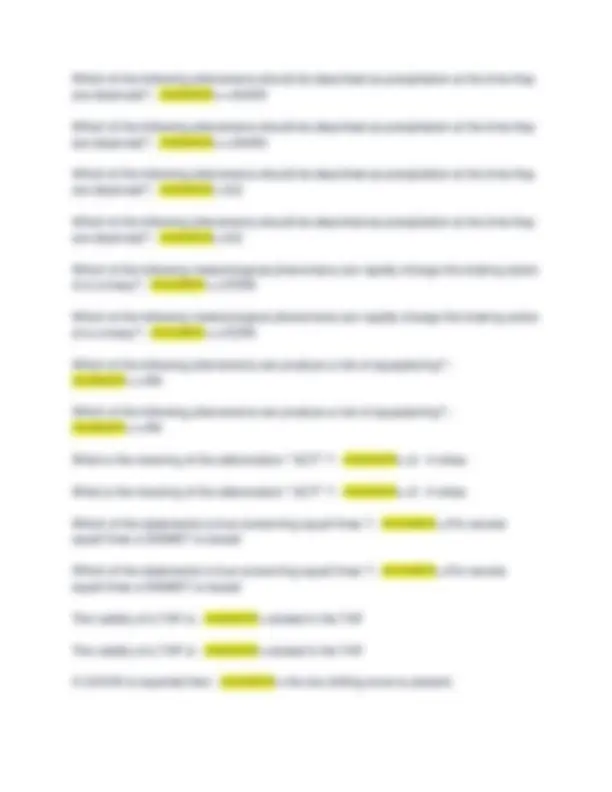
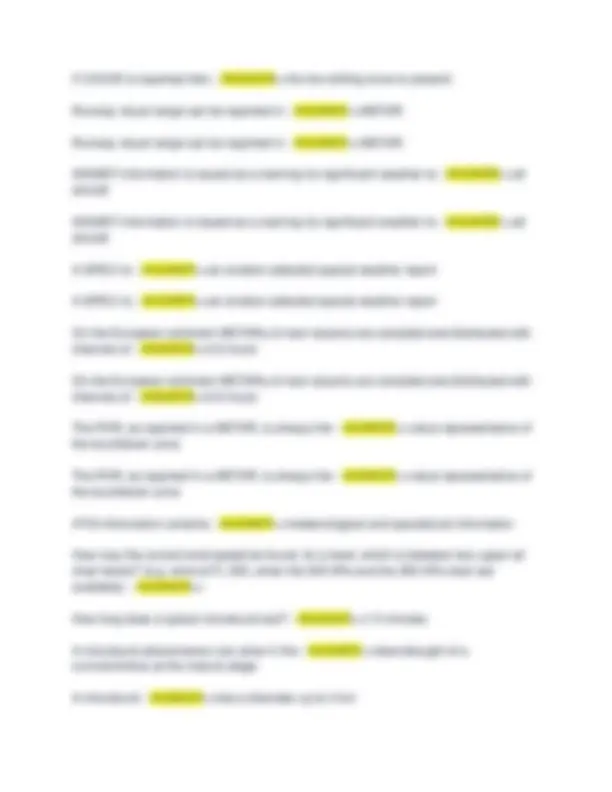

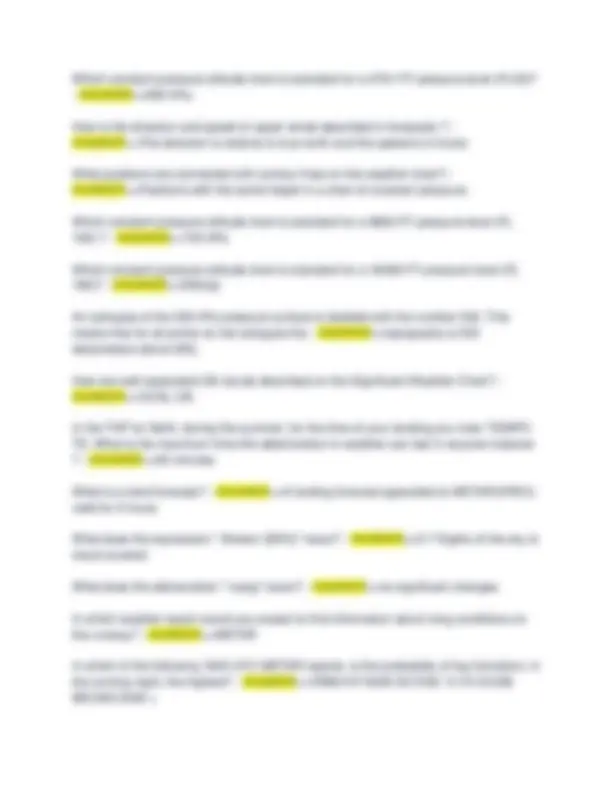
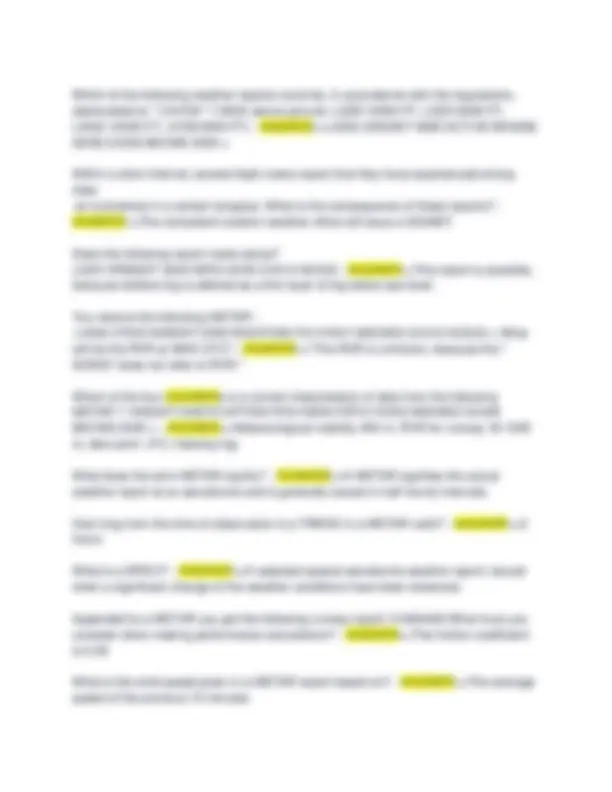
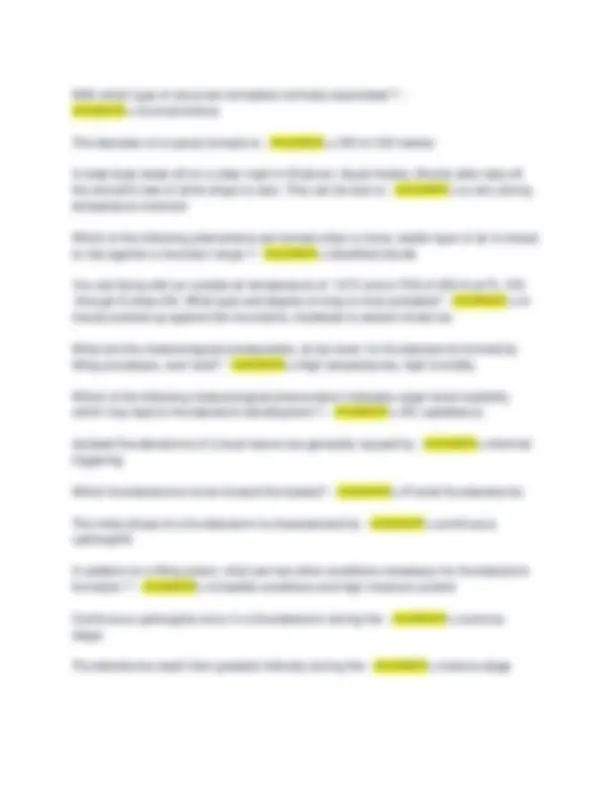
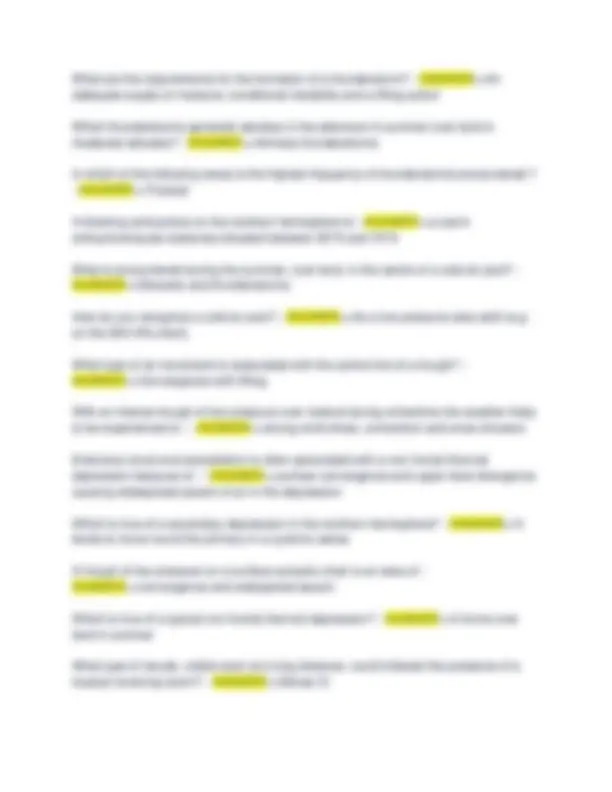
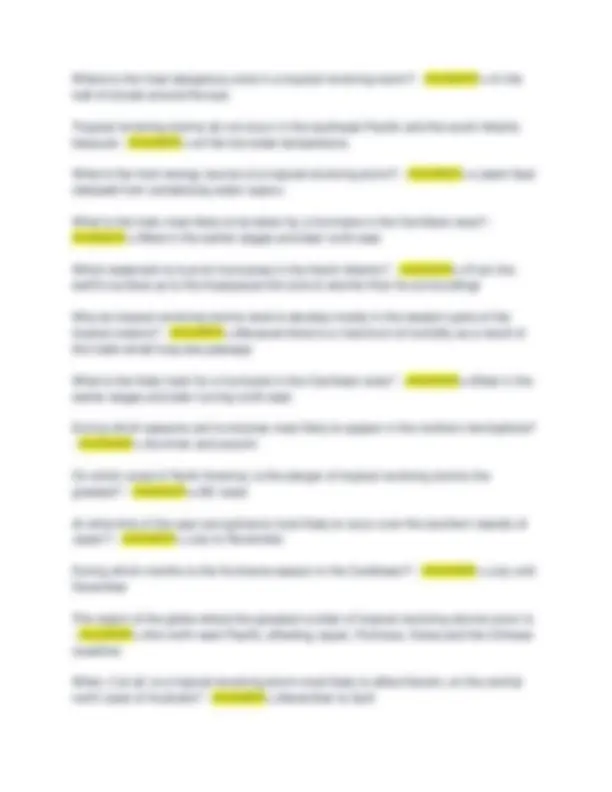



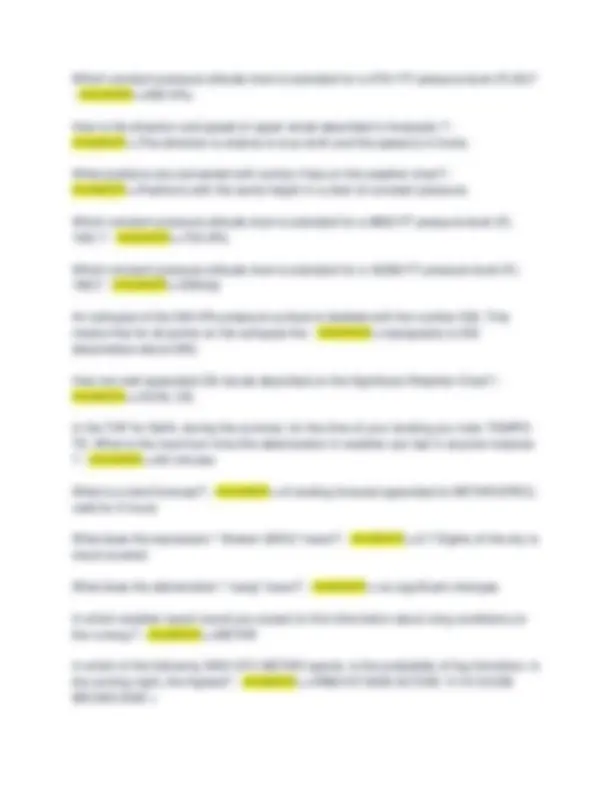

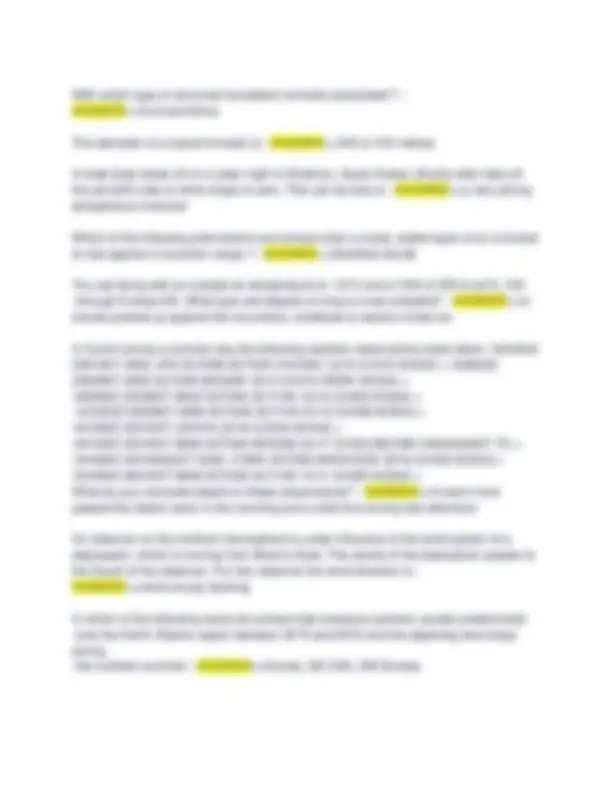
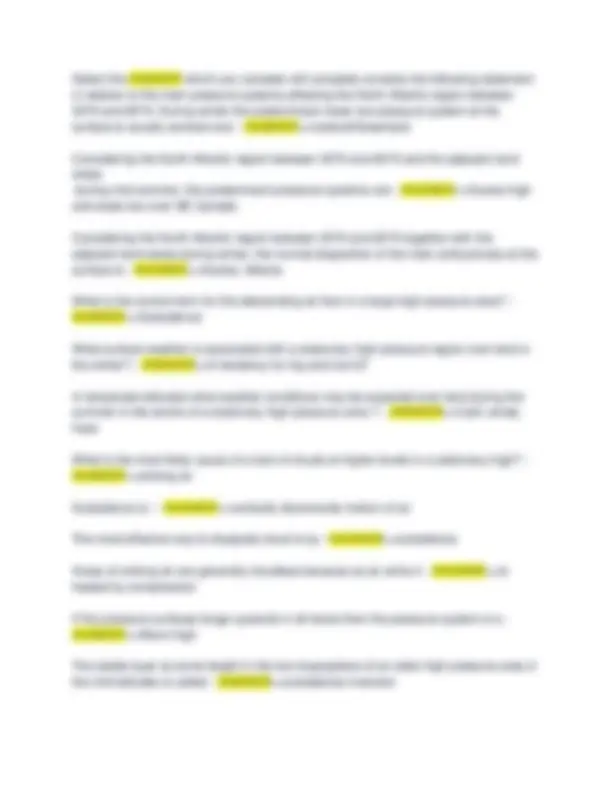
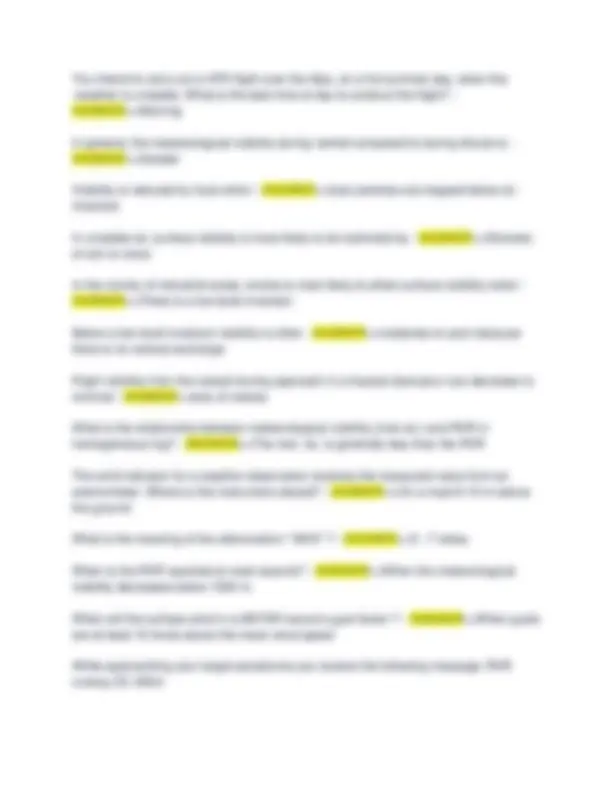
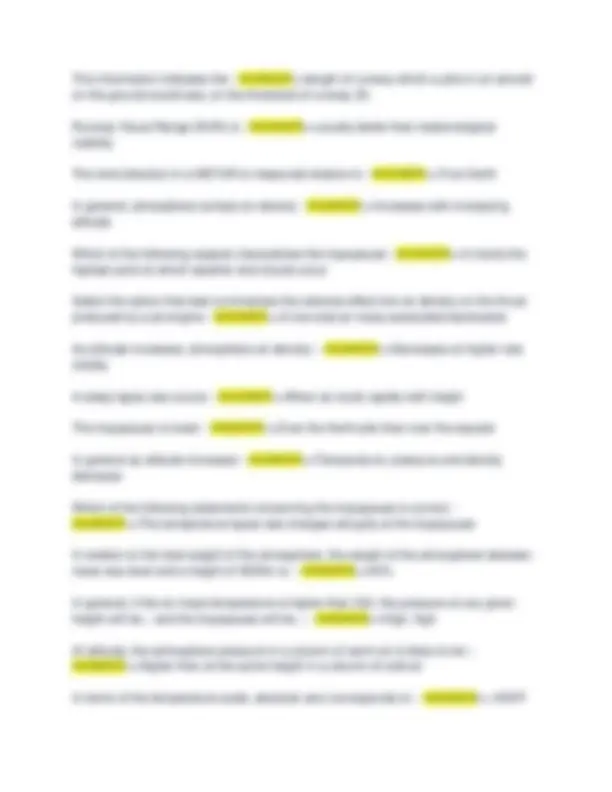
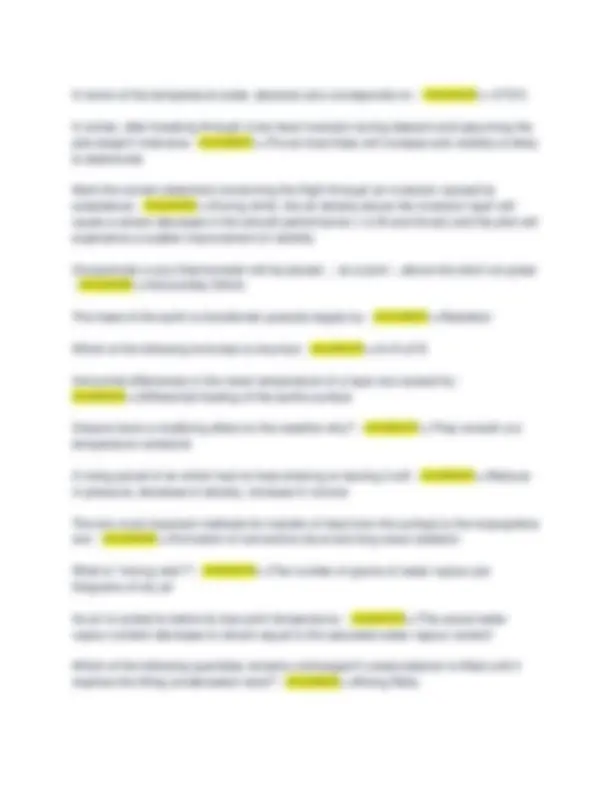

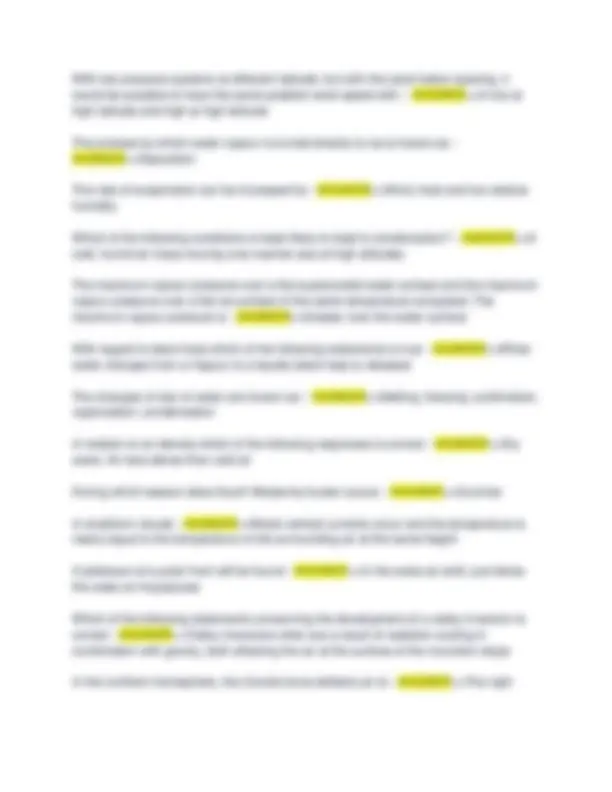
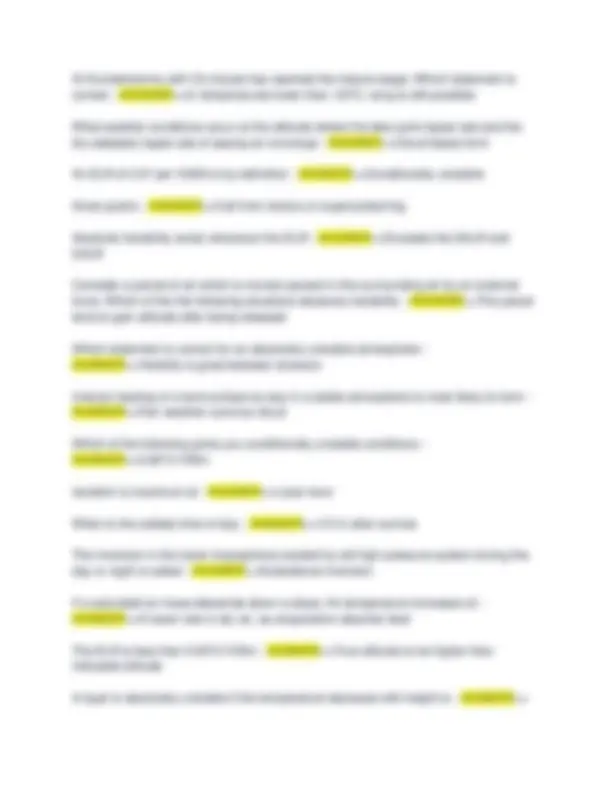

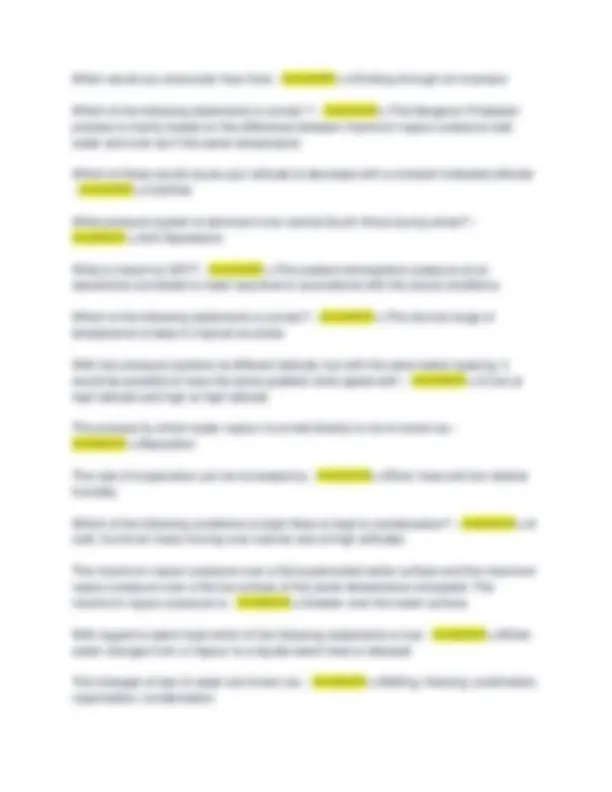
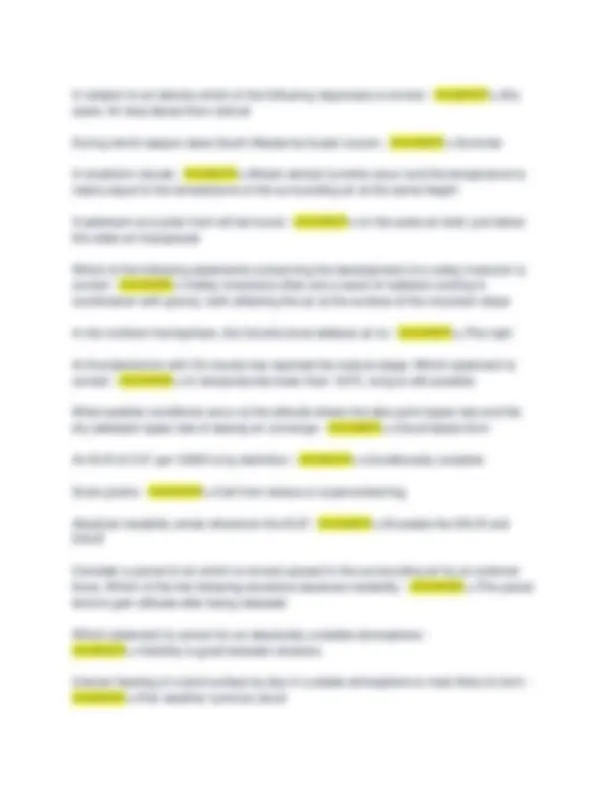
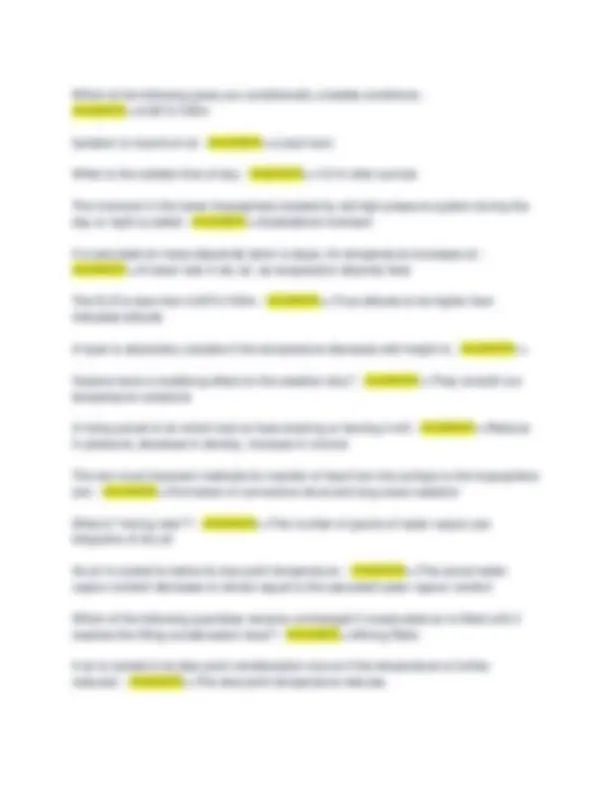

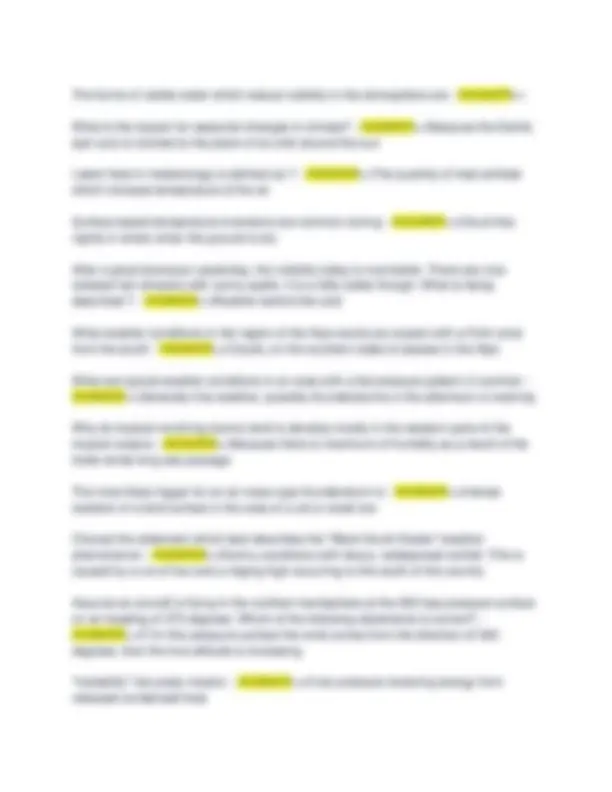




Study with the several resources on Docsity

Earn points by helping other students or get them with a premium plan


Prepare for your exams
Study with the several resources on Docsity

Earn points to download
Earn points by helping other students or get them with a premium plan
Community
Ask the community for help and clear up your study doubts
Discover the best universities in your country according to Docsity users
Free resources
Download our free guides on studying techniques, anxiety management strategies, and thesis advice from Docsity tutors
ATPL Meteorology Exam Questions With Verified Correct Answers
Typology: Exams
1 / 81

This page cannot be seen from the preview
Don't miss anything!










































































How does the height of the tropopause vary with latitude in the northern hemisphere - ANSWER>>It decreases from south to north Which cloud type may indicate severe turbulence - ANSWER>>Altocumulus lenticularis Fair weather cumulus often is indication of - ANSWER>>Turbulence at and below cloud level On a clear summer day, turbulence caused by solar heating is most - ANSWER>>During the early afternoon Generally northern hemisphere winds at 5000 FT/AGL are southwesterly while most of the surface winds are southerly. What is the primary reason of difference between these two wind directions? - ANSWER>>Friction between the wind and the surface Friction between the air and the ground results in the northern hemisphere - ANSWER>>Backing of the wind and decrease in wind speed at the surface You are flying at 2 500 FT/AGL, with a southerly wind, and intend to land at an airport, at sea level directly below. From approximately which direction would you expect the surface wind (mid-latitude, northern hemisphere)? - ANSWER>>South-south east In the lower layers of the atmosphere due to friction the wind changes direction towards the low pressure area because : - ANSWER>>Wind speed decreases and therefore Coriolis force decreases What causes surface winds to flow across the isobars at an angle rather than parallel to the isobars - ANSWER>>Surface friction If Paris reports a wind of 08010KT on the METAR, what wind velocity would you expect to encounter at a height of 2000 feet above the ground? - ANSWER>>11020kt
If Paris reports a wind of 16020KT on the METAR, what wind velocity would you expect to encounter at a height of 2000 feet above the ground? - ANSWER>>19040kt If Paris reports a wind of 30012KT on the METAR, what wind velocity would you expect to encounter at a height of 2000 feet above the ground? - ANSWER>>33025kt In the northern hemisphere a pilot flying at 1000 FT/AGL directly towards the centre of a low pressure area, will find the wind blowing from - ANSWER>>Left and behind In the northern hemisphere the wind at the surface blows - ANSWER>>counter- clockwise around, and toward the centre of, a low pressure area During a descent from 2000 FT above the surface to the surface (no frontal passage) the wind normally - ANSWER>>Back and decrease What relationship exists between the wind at 3000 feet and the surface wind? - ANSWER>>The wind at 3000 feet is parallel to the isohypses and the surface wind direction is across the isobars toward the low pressure and the surface wind is weaker. The vertical extent of the friction layer depends primarily on - ANSWER>>stability, wind speed, roughness of surface During periods of prolonged clear skies associated with anticyclonic conditions, the - ANSWER>>Surface wind speed tends to highest during early afternoon In the northern hemisphere the gradient wind of a cyclonic pressure distribution is 350/24, over the sea the surface wind would approximate - ANSWER>>340/ In the northern hemisphere with an anticyclonic pressure system the geostrophic wind at 2000 FT over the sea is 060/15. At the same position the surface wind is most likely to be - ANSWER>>045/ At the approach of a warm front (northern hemisphere) the wind direction changes from the surface up to the tropopause. The effect of this change is that the wind - ANSWER>>Veers in the friction layer and veers above the friction layer
What is the approximate ratio between height and width for a jet stream cross section? - ANSWER>>1/ An aircraft is flying from south to north, above the polar front jet stream, at FL 400 in the southern hemisphere. What change, if any, in temperature will be experienced? - ANSWER>>It falls A wind speed of 350 kt within a jet stream core should be world-wide regarded as: - ANSWER>>Possible but a very rare phenomenon An aircraft over Western Europe is crossing a jet stream 2500 FT below its core at right angles. While crossing, the outside temperature is increasing. The prevailing wind is - ANSWER>>From the right What is the minimum speed for a wind to be classified as a jet stream? - ANSWER>>60kt A wind sounding in the region of a polar front jet stream gives the following windprofile (Northern hemisphere). 900hPa 220/20kt 800hPa 220/25kt 700hPa 230/35kt 500hPa 260/60kt 400hPa 280/85kt 300hPa 300/100kt 250hPa 310/120kt 200hPa 310/80kt Which system is the jet stream associated with? - ANSWER>>With a farm front Where, as a general rule, is the core of the polar front jet stream to be found? - ANSWER>>In a warm air mass You cross a jet stream in horizontal flight at approximately right angles. While crossing, in spite of a strong wind of 120 kt, you notice the temperature barely changes. - ANSWER>>This phenomenon is absolutely normal as you are crossing the jet core What jet streams are likely to be crossed during a flight from Stockholm to Rio de Janeiro
(23°S) at FL 350 in July? - ANSWER>>A polar front jet stream followed by one or two subtropical jet streams. An aircraft is approaching under visual flight rules an airfield whose runway is parallel to the coast. When downwind over the sea, the airfield is on the left. What wind effect should be anticipated on final approach and landing during a sunny afternoon - ANSWER>>Crosswind from the left Which cloud type may indicate severe turbulence - ANSWER>>Altocumulus lenticularis What approximately is the average height of the tropopause over the equator - ANSWER>>16km In which later is the most atmospheric humidity concentrated? - ANSWER>>Troposphere What is the boundary layer between the troposphere and stratosphere called - ANSWER>>Tropopause which of the following cloud type can project up into the stratosphere - ANSWER>>Cumulonimbus Which of the following statements apply to the tropopause? - ANSWER>>It separates the troposphere and stratosphere The thickness of the troposphere varies with - ANSWER>>Latitude Which layer of the atmosphere varies more than 90% of water vapour - ANSWER>>Troposphere Going from the equator to the North Pole, the altitude of the tropopause - ANSWER>>Decreased and it's temperature increases The troposphere is - ANSWER>>Part of atmosphere below the tropopause The tropopause is the level at which - ANSWER>>Temperature ceases to fall with increasing height The tropopause is lower - ANSWER>>Over the North Pole than over the equator
Absolute instability exists whenever the environmental lapse rate - ANSWER>>Exceeds the dry adiabatic lapse rate In an air mass with no clouds the surface temperature is - 15°C and 13°C at 1000m. This layer of air is - ANSWER>>Stable An inversion is a layer of air which is - ANSWER>>Absolutely stable The environmental lapse rate in the actual atmosphere - ANSWER>>Varies with time The dry adiabatic lapse rate has a value of - ANSWER>>1°C/1000m The dry adiabatic lapse rate - ANSWER>>Has a constant fixed value An air mass is called stable when - ANSWER>>The vertical motion of the rising air tends to become weaker and disappear A layer can be - ANSWER>>Stable for unsaturated air and stable for saturated air When in the upper part of a layer warm air is advected the - ANSWER>>Stability increases in the layer I'm still air the temperature decreases at an average of 1.2°C per 100m and increases in altitude. The change in temperature is called? - ANSWER>>Environmental lapse rate From which of the following pieces of information can the stability of the atmosphere be derived - ANSWER>>The environmental lapse rate The value of the saturated adiabatic lapse rate is closest to that of the dry adiabatic lapse rate in - ANSWER>>Cirrus Which of the following is the common cause of ground or surface temperature inversion
Which is the technical term for an increase in temperature with altitude - ANSWER>>An inversion An inversion is a layer of air at which the temperature - ANSWER>>Increases with height An isothermal layer of air in which the temperature - ANSWER>>Remains constant with height An inversion is - ANSWER>>An increase in temperature with height A significant inversion at low height is a characteristic of - ANSWER>>Nocturnal radiation The diurnal variation in temperature is largest when the sky is - ANSWER>>Clear and winds are weak On a clear sky, continental ground surface, wind calm, the minimum temperature is reach approximately at - ANSWER>>Half an hour after sunrise What positions are connected after isobars on the surface weather charts - ANSWER>>Positions with the same air pressures at a given level The isobars drawn on the surface weather charts represent lines of equal pressure - ANSWER>>Reduced to see level The station pressure used in surface weather charts is - ANSWER>>QFF Isobars on a surface weather chart are lines of equal - ANSWER>>QFF In the troposphere the decrease of pressure per 100m increase in height - ANSWER>>Is smaller at higher levels than lower levels Which of the following is true concerning atmospheric pressure - ANSWER>>It decreases with height An isohypse (contour) - ANSWER>>Indicates the true altitude of a pressure level In order to calculate QFE from QNH, which if the following must be known? - ANSWER>>Elevation of the airfield
QNH is defined as - ANSWER>>QFE reduced to MSL using the values of standard atmosphere In order to reduce QFE to QNH, which of the following item(s) must be known - ANSWER>>Elevation of airfield At FL 180, the air temperature is - 35°C. The air density at this level is: - ANSWER>>Greater than the density of ISA atmosphere at FL 180 Under what conditions does pressure altitude has the same value as density altitude - ANSWER>>At standard temperature Half the atmosphere is found in the first - ANSWER>>5km The lowest assumed temperature in the ISA is : - ANSWER>>-56.5°C A 200hpa pressure altitude level can vary in height. In temperate regions which of the following average height is applicable - ANSWER>>FL 390 How temperature vary with increasing altitude in the ICAO standard atmosphere below the tropopause - ANSWER>>Decreases What is the vertical temperature lapse rate up to 11km, in the standard ICAO atmosphere? - ANSWER>>6.5°C per 1000m A 300hpa level can vary in height. In temperate regions which of the following average heights is applicable? - ANSWER>>FL 300 A 500hpa level can vary in height. In temperate regions which of the following average heights is applicable? - ANSWER>>FL 180 A 700hpa level can vary in height. In temperate regions which of the following average heights is applicable? - ANSWER>>FL 100 A 850hpa level can vary in height. In temperate regions which of the following average heights is applicable? - ANSWER>>FL 50 If you are flying at FL 300 in an air mass that is 15°C warmer than a standard atmosphere, what is the outside temperature likely to be? - ANSWER>>-30°C
If you are flying at FL 100 in an air mass that is 10°C warmer than a standard atmosphere, what is the outside temperature likely to be? - ANSWER>>+5°C If you are flying at FL 120 and outside temperature is - 2°C, what is the altitude at freezing level? - ANSWER>>FL 110 The temperature at 1000 FT in the ISA is - ANSWER>>-5°C The rate of decrease of temperature with height per 100m in ISA is: - ANSWER>>0.65°C In the ISA the decrease in temperature with height below 11km - ANSWER>>0.65°C per 100m Which statement is correct regarding ISA? - ANSWER>>At MSL ISA temperature is 15°C pressure is 1013hpa In what hpa a range is an upper weather chart for FL 340 situated? - ANSWER>>300- 200 hpa Which of the following conditions can cause the altimeter to indicate a lower altitude than is actually been flown? - ANSWER>>Air temperature higher than standard An aircraft flying at FL 100 from Marseille (QNH 1012 hPa) to Palma de Mallorca (QNH 1006 hPa) experiences no change to true altitude. The reason for this is that - ANSWER>>The air at Palma de Mallorca is warmer than the air at Marseille During a flight over the sea at FL 100 from Marseille (QNH 1012 hPa) to Palma de Mallorca (QNH 1012 hPa), the true altitude is constantly increasing. What action, if any, should be taken? - ANSWER>>None, the reason for the change is that the air around Palma is warmer than the air around Marseille During a flight over the sea at FL 100 from Marseille (QNH 1016 hPa) to Palma de Mallorca (QNH 1016 hPa), the true altitude is constantly decreasing. What is the probable reason for this? - ANSWER>>The air at Palma de Mallorca is warmer than the air at Marseille
An aircraft descending to land under IFR if the local QNH is 1009 hPa, what will happen to the altitude reading when the altimeter is reset at the transition level? - ANSWER>>It will decrease During the climb after take-off, the altimeter setting is adjusted at the transition altitude. If the local QNH is 1023 hPa, what will happen to the altimeter reading during the resetting procedure? - ANSWER>>It will decrease During the climb after takeoff, the altimeter setting is adjusted at the transition altitude. If the local QNH is 966 hPa, what will happen to the altimeter reading during the resetting procedure? - ANSWER>>It will increase Which of the following statements is true - ANSWER>>QNH can be equal to QFE Which statement is true - ANSWER>>QNH can be lower as well as higher than 1013.25hpa When the sub scale is set to QNH of an airfield the pressure altimeter indicates - ANSWER>>Elevation while landing The QNH is equal to the QFE if - ANSWER>>The elevation = 0 Which of the following conditions give the highest value of the QNH - ANSWER>>QFE = 995 hpa, elevation =1600ft (488m) You must make an emergency landing at sea. The QNH of a field on a nearby island with an elevation of 4000 FT is 1025 hPa and the temperature is - 20°C. What is your pressure altimeter reading when landing if 1025 hPa is set in the subscale? - ANSWER>>Less than 0FT Before landing, an altimeter set to QFE indicates - ANSWER>>In standard atmosphere, the height of the aircraft above the official airport elevation Which weather condition lowers true altitude as compared to pressure altitude to a position where flights over mountains could be dangerous - ANSWER>>Cold low
At which pressure and temperature conditions may you safely assume that the minimum usable flight level at least lies at the same height, as the minimum safe altitude? hPa - ANSWER>>At a temperature greater than or equal to that of the ISA and where the QNH is greater than or equal to 1013 What information is required to convert a minimum safe altitude into a lowest usable flight level - ANSWER>>Lowest value of QNH and the highest negative temperature deviation from ISA. What is the approximate speed of a 25-knot wind, expressed in kilometres per hour? - ANSWER>>45km/h What is the approximate speed of a 90km/h wind, expressed in kilometres per hour? - ANSWER>>50kt What is the approximate speed of a 40-knot wind, expressed in kilometres per hour? - ANSWER>>20m/sec What values are used for a forecasted wind at higher levels - ANSWER>>Direction relative to true north and speed in knots Which forces are balanced with geostrophic winds - ANSWER>>Pressure gradient force and coriolis force Whilst flying at FL 180 on the northern hemisphere an aircraft experiences right drift. What effect, if any, will this have on the aircraft's true altitude? - ANSWER>>It decreases In the southern hemisphere what wind effect would you expect when flying from a high pressure area towards a low pressure area at FL 100? - ANSWER>>Wind from the right The geostrophic wind is greater than the gradient wind around a low pressure system because the - ANSWER>>centrifugal force opposes the pressure gradient The geostrophic wind is less than the gradient wind around the anti-cyclone because the - ANSWER>>centrifugal force is added to the pressure gradient
For a similar pressure gradient, the geostrophic wind speed will be - ANSWER>>greater at 30°N than 60°N For same pressure gradient at 60°N, 50°N and 40°N the speed of the geostrophic wind will be - ANSWER>>Greatest 40°N Under anticyclone conditions in the northern hemisphere, with curved isobars the speed of the gradient wind is - ANSWER>>Greater than geostrophic winds What characteristics will the surface winds have in an area where the isobars on the weather map are very close together? - ANSWER>>Strong and flowing across isobars Select the true statement concerning isobars and wind flow patterns around high- and low-pressure systems that are shown on a surface weather chart. - ANSWER>>When the isobars are close together, the pressure gradient force is greater and wind velocities are stronger. Where are you likely to find the strongest winds close to the ground? - ANSWER>>The transitional zone between two air masses The greater the pressure gradient the - ANSWER>>Closer the isobars and the stronger the wind When isobars, for an area in the mid-latitudes on a weather map, are close together, the wind is most likely to be - ANSWER>>Strong Which of the following is true concerning an aircraft that is flying at FL180 in the northern hemisphere, where wind is geostrophic and the true altitude remains constant? - ANSWER>>There is no cross wind In an area of converging air - ANSWER>>Clouds can form Divergence in the upper air results, near the surface in - ANSWER>>falling pressure and likely formation of clouds In a low pressure system the convergence at the surface is caused by - ANSWER>>frictional forces
Between which latitudes are you most likely to find the subtropical high-pressure belt? - ANSWER>>25°-35°C Between which latitudes are you most likely to find the region of travelling low pressure systems? - ANSWER>>55°-75°C In the central part of the Atlantic Ocean between 10°N and 20°N the prevailing winds are - ANSWER>>NE trade winds Which degree of aircraft turbulence is determined by the following ICAO description? " There may be moderate changes in aircraft attitude and/or altitude but the aircraft remains in positive control at all times. Usually, small variations in air speed. Changes in accelerometer readings of 0.5 to 1.0 g at the aircraft's center of gravity. Occupants feel strain against seat belts. Loose objects move about. Food service and walking are difficult." - ANSWER>>Moderate All pilots encountering Clear Air Turbulence are requested to report it. You experience CAT which causes passengers and crew to feel definite strain against their seat belt or shoulders straps. Unsecured objects are dislodged. Food service and walking are difficult. This intensity of CAT should be reported as - ANSWER>>Moderate What degree of turbulence, if any, is likely to be encountered while flying through a cold front in the summer over Central Europe at FL 100? - ANSWER>>Severe turbulence and CB clouds While crossing a jet stream at right angles in Western Europe (3000 FT below its core) and OAT is decreasing, what would be the prevailing wind? - ANSWER>>Crosswind from the left Where, in Central Europe, are the highest wind speeds to be found - ANSWER>>Just below the tropopause Which of the following statements concerning jet streams are true - ANSWER>>In the northern hemisphere both westerly and easterly jet streams occur Which of the following statements concerning the core of a polar jet stream is correct - ANSWER>>It lies at a height where there is no horizontal temperature gradient the slope of the pressure surfaces at the height of the core is at its maximum
In which zone of a jet stream is the strongest CAT to be expected? - ANSWER>>Cold air side of the core Which area of a polar front jet stream in the northern hemisphere has the highest probability of turbulence? - ANSWER>>looking downstream, the area to the left of the core Under which of the following conditions is the most severe CAT likely to be experienced? - ANSWER>>A curved jet stream near a deep through Which of the following conditions are most favourable to the formation of mountain waves? - ANSWER>>Stable air at mountain top altitude and a wind at least 20 knots blowing across the mountain ridge At the top of orographic waves, in mountainous regions, the cloud most likely to be encountered is - ANSWER>>Altocumulus lenticularis What of the following is the most important constituent in the atmosphere from a weather stand-point? - ANSWER>>Water vapour What does dew point mean? - ANSWER>>The temperature to which a mass of air must be cooled in order to reach saturation Which of the following is the definition of relative humidity? - ANSWER>>Ratio between the actual mixing ratio and the saturation mixing ratio X 100 The relative humidity of a sample air mass is 50%. How is the relative humidity of this air mass influenced by changes of the amount of water vapour in it? - ANSWER>>It increases with increasing water vapour Relative humidity - ANSWER>>Changes when water vapour is added even though the temperature remains constant How, if at all, is the relative humidity of an unsaturated airmass influenced by temperature changes? - ANSWER>>It decreases with increasing temperature How does relative humidity and the dewpoint in an unsaturated air mass change with varying temperature? - ANSWER>>When temperature increases, the relative humidity decreases, and the dewpoint remains constant.
When a given mass of air descends, what effect will it have on relative humidity? - ANSWER>>it decreases During the late afternoon an air temperature of +12°C and a dew point of +5°C were measured. What temperature change must occur during the night in order to induce saturation? - ANSWER>>It must decrease to +5°C Which of the following statements is true of the dew point of an air mass? - ANSWER>>In can only be equal to or lower than the temperature of the air mass relative humidity - ANSWER>>increases if the air is cooled whilst maintaining the vapour pressure constant The difference between temperature and dewpoint is greater in - ANSWER>>Dry air The dew point temperature - ANSWER>>Can be equal to air temperature Relative humidity depends on - ANSWER>>Moisture content and temperature of the air The dew point temperature - ANSWER>>Can be reached by cooling the air while keeping pressure constant The maximum amount of water vapour that the air can contain depends on the - ANSWER>>Air temperature Dew point is defined as - ANSWER>>The temperature to which moist air must be cooled to become saturated at a given pressure Relative humidity at a given temperature is the relation between - ANSWER>>actual water vapour content and saturated water vapour content Which of the following changes of state is known as sublimation? - ANSWER>>Solid direct to vapour Clouds, fog or dew will always be formed when - ANSWER>>water vapor condenses In which of the following changes of state is latent heat released? - ANSWER>>Gas to liquid